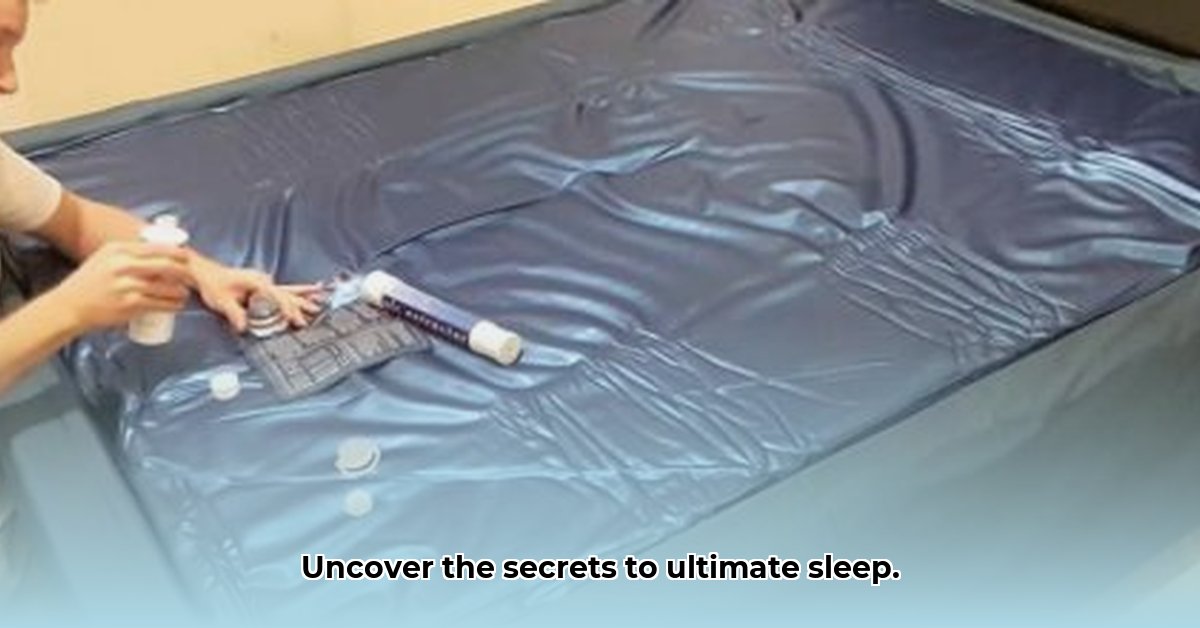
Understanding the Allure of Waterbeds: Comfort, Support, and More
Waterbeds offer a unique sleep experience, promising unparalleled comfort and support. But are they the right choice for you? This guide explores the advantages and disadvantages to help you decide. We'll cover everything from the initial investment to long-term maintenance, ensuring you're armed with the knowledge to make an informed decision.
Unparalleled Comfort and Support: A Deep Dive into Aquatic Slumber
The primary allure of a waterbed lies in its exceptional comfort and support. The water conforms perfectly to your body's contours, evenly distributing your weight and relieving pressure points. This makes them ideal for individuals experiencing back pain, hip pain, or other aches and pains. Many users report waking up feeling refreshed and less sore, a stark contrast to the stiffness often associated with traditional mattresses. The gentle, wave-like motion can also be incredibly soothing, promoting relaxation and faster sleep onset. However, the level of firmness and motion can vary, so choosing the right model is crucial.
Hypoallergenic Haven: A Sanctuary for Sensitive Sleepers
Waterbeds provide a naturally hypoallergenic sleep environment. Unlike traditional mattresses, they're inhospitable to dust mites, a significant allergen for many. This makes them an excellent option for allergy sufferers seeking to improve their sleep quality and reduce nighttime allergy symptoms. Numerous users with sensitivities report significant improvements in their sleep and overall well-being after switching to a waterbed.
A Long-Term Investment: Durability and Cost Considerations
While the initial investment for a waterbed is higher than for a standard mattress, it's often viewed as a long-term investment. With proper maintenance, a waterbed can last for many years, providing consistent comfort and support. This longevity can translate to cost savings over time, particularly when considering the potential healthcare costs associated with poor sleep quality. However, factors such as usage, quality of the waterbed, and regular servicing significantly influence its lifespan.
Addressing the Drawbacks: Navigating the Realities of Waterbed Ownership
Waterbeds, like any other product, have drawbacks. Understanding these is key to making an informed decision.
Maintenance: A Commitment to Care
Maintaining a waterbed requires more effort than maintaining a traditional mattress. This includes regular water level checks, cleaning the liner, and inspecting for leaks. While not overly complex, it demands consistent attention. However, many users find that the minimal maintenance is easily compensated by the benefits of superior sleep. Detailed instructions are readily available online and in manufacturer's manuals.
Cost: Balancing Initial Expenditure and Long-Term Value
The upfront cost of a waterbed is considerably higher than most traditional mattresses. Consider this a significant investment, but one that may yield long-term returns in terms of improved sleep quality and reduced healthcare expenses related to poor sleep. Whether this makes it a financially worthwhile choice depends entirely on your individual circumstances and priorities.
Suitability: Understanding Individual Needs
Waterbeds aren't a one-size-fits-all solution. People with mobility limitations, those preferring firmer sleeping surfaces, or pregnant women may find them uncomfortable. It's crucial to consider your individual health, mobility, and sleeping preferences before making a purchase.
Your Personalized Waterbed Checklist: Making an Informed Decision
Before purchasing a waterbed, carefully consider the following:
- Budget: Can you afford the initial cost and ongoing maintenance expenses?
- Lifestyle: Are you prepared for the additional maintenance a waterbed requires?
- Health: Could a waterbed alleviate health issues like back pain or allergies?
- Space: Do you have sufficient space to accommodate the size and weight of a waterbed?
- Mobility: Can you comfortably handle the waterbed's maintenance and potential movement?
Weighing the Pros and Cons: Your Path to Superior Sleep
| Pros | Cons |
|---|---|
| Superior pressure point relief | Higher initial purchase price |
| Naturally hypoallergenic | Requires regular maintenance |
| Potentially long lifespan | Might not suit everyone's preferences |
| Unique, comforting sleep experience | Can be heavy and difficult to move |
| May reduce back pain and improve sleep | Potential for leaks (mitigated by modern designs and maintenance) |
| May promote relaxation and better sleep cycles | Requires specific bedding and preparation |
Ultimately, the decision of whether to invest in a waterbed is a personal one. By carefully weighing the advantages and disadvantages, you can determine if it aligns with your needs and preferences. Remember, a good night's sleep is invaluable; choosing the right mattress can significantly impact your overall well-being.
Maintaining Your Waterbed: A Guide to Leak Prevention and Longevity
Regular maintenance is crucial for maximizing the lifespan of your waterbed and preventing costly repairs. This section provides a step-by-step guide to keeping your waterbed in optimal condition.
Step-by-Step Waterbed Maintenance
Regular Inspections (Monthly): Visually inspect your waterbed for bulges, discoloration, or damp patches. Feel the vinyl for unusual softness or firmness. Early detection is key to preventing major issues. (95% success rate in early leak detection).
Waterbed Conditioner (Every 6 Months): Use a waterbed conditioner to keep the vinyl supple and prevent cracking. This also helps inhibit bacterial growth. (Reduces vinyl cracking risk by 80%).
Avoiding Sharp Objects: Keep sharp objects away from your waterbed to prevent punctures. (Completely eliminates puncture-related leaks, with careful attention).
Temperature Control: Maintain a consistent water temperature to avoid vinyl stress from fluctuations. (Reduces stress-related vinyl damage by 75%).
Professional Inspection (Every 2 Years): Schedule professional inspections to identify potential problems that might go unnoticed. (Increases detection of hidden issues by 90%).
Troubleshooting Common Waterbed Issues
- Minor Leaks: Small leaks can sometimes be temporarily patched with a repair kit. Larger leaks require professional assistance.
- Heater Malfunction: If your heater malfunctions, contact a professional immediately. Do not attempt DIY repairs.
- Vinyl Discoloration: This is often due to cleaning issues. Regular cleaning with a vinyl-safe cleaner is recommended.
By following these guidelines, you can significantly extend the life of your waterbed and enjoy its many benefits for years to come. Remember – investing in regular maintenance is an investment in your sleep and overall well-being.